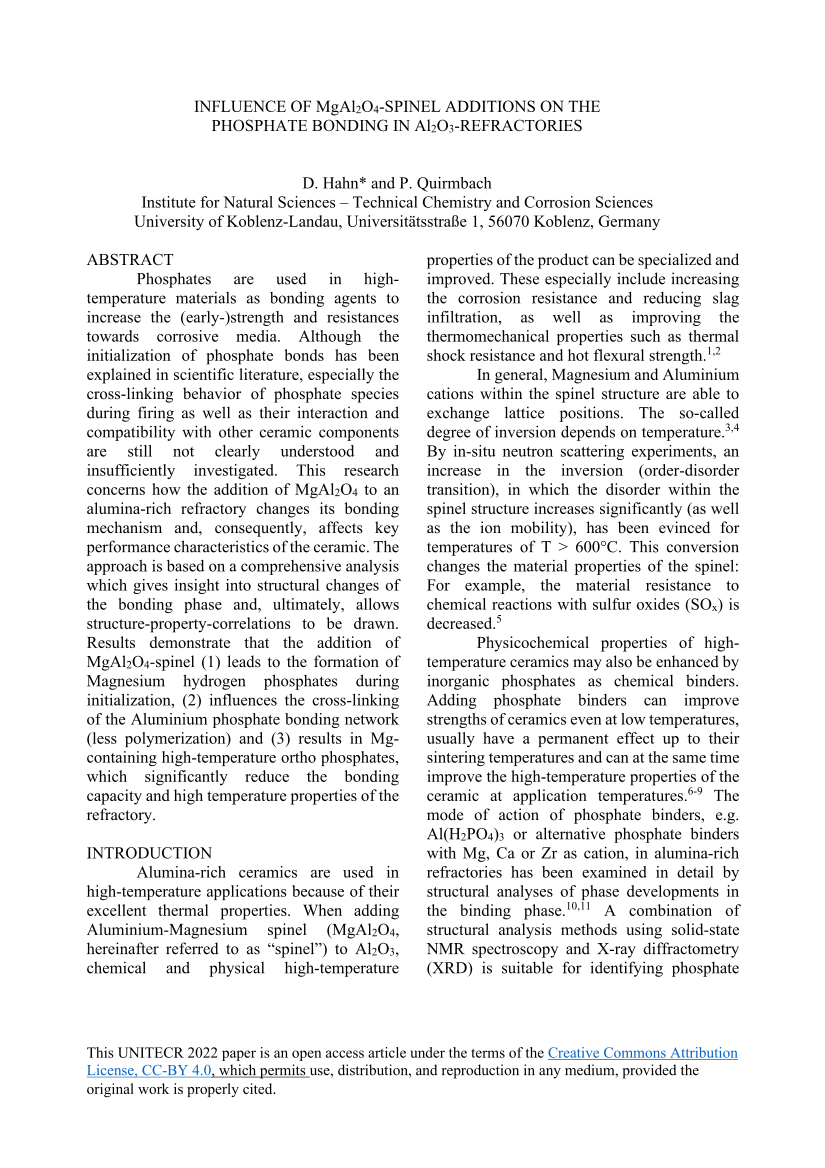This UNITECR 2022 paper is an open access article under the terms of the Creative Commons Attribution License, CC-BY 4.0, which permits use, distribution, and reproduction in any medium, provided the original work is properly cited. INFLUENCE OF MgAl2O4-SPINEL ADDITIONS ON THE PHOSPHATE BONDING IN Al2O3-REFRACTORIES D. Hahn* and P. Quirmbach Institute for Natural Sciences – Technical Chemistry and Corrosion Sciences University of Koblenz-Landau, Universitätsstraße 1, 56070 Koblenz, Germany ABSTRACT Phosphates are used in high- temperature materials as bonding agents to increase the (early-)strength and resistances towards corrosive media. Although the initialization of phosphate bonds has been explained in scientific literature, especially the cross-linking behavior of phosphate species during firing as well as their interaction and compatibility with other ceramic components are still not clearly understood and insufficiently investigated. This research concerns how the addition of MgAl2O4 to an alumina-rich refractory changes its bonding mechanism and, consequently, affects key performance characteristics of the ceramic. The approach is based on a comprehensive analysis which gives insight into structural changes of the bonding phase and, ultimately, allows structure-property-correlations to be drawn. Results demonstrate that the addition of MgAl2O4-spinel (1) leads to the formation of Magnesium hydrogen phosphates during initialization, (2) influences the cross-linking of the Aluminium phosphate bonding network (less polymerization) and (3) results in Mg- containing high-temperature ortho phosphates, which significantly reduce the bonding capacity and high temperature properties of the refractory. INTRODUCTION Alumina-rich ceramics are used in high-temperature applications because of their excellent thermal properties. When adding Aluminium-Magnesium spinel (MgAl2O4, hereinafter referred to as “spinel”) to Al2O3, chemical and physical high-temperature properties of the product can be specialized and improved. These especially include increasing the corrosion resistance and reducing slag infiltration, as well as improving the thermomechanical properties such as thermal shock resistance and hot flexural strength.1,2 In general, Magnesium and Aluminium cations within the spinel structure are able to exchange lattice positions. The so-called degree of inversion depends on temperature.3,4 By in-situ neutron scattering experiments, an increase in the inversion (order-disorder transition), in which the disorder within the spinel structure increases significantly (as well as the ion mobility), has been evinced for temperatures of T 600°C. This conversion changes the material properties of the spinel: For example, the material resistance to chemical reactions with sulfur oxides (SOx) is decreased.5 Physicochemical properties of high- temperature ceramics may also be enhanced by inorganic phosphates as chemical binders. Adding phosphate binders can improve strengths of ceramics even at low temperatures, usually have a permanent effect up to their sintering temperatures and can at the same time improve the high-temperature properties of the ceramic at application temperatures.6-9 The mode of action of phosphate binders, e.g. Al(H2PO4)3 or alternative phosphate binders with Mg, Ca or Zr as cation, in alumina-rich refractories has been examined in detail by structural analyses of phase developments in the binding phase.10,11 A combination of structural analysis methods using solid-state NMR spectroscopy and X-ray diffractometry (XRD) is suitable for identifying phosphate
(c) 2024 American Ceramic Society. All Rights reserved.








